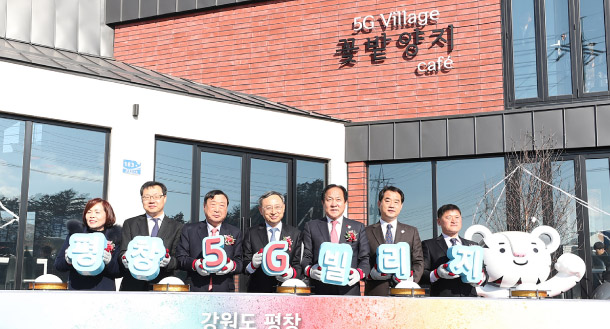KT wires up village near Pyeongchang with 5G

KT Chairman Hwang Chang-gyu, fourth from left, and Lee hee-beom, president of the PyeongChang Olympics’ organizing committee, third from right, as well as other officials celebrate the opening Wednesday of the 5G Village in Euiyaji, Gangwon. [KT]
The village, called Euiyaji, is at an altitude of 700 meters (2,297 feet), which helps explain its nickname, “Wind Village.” Its residents grow napa cabbages and carrots and breed sheep.
Having been plugged into a network as much as 20 times faster than the current long-term evolution network, or 4G, Euiyaji has a new nickname: Pyeongchang 5G Village.
People attending the Winter games can swing by to get a glimpse of the future world. Shuttles will run between Pyeongchang and the village during the Olympics. A newly built two-story cafe is the centerpiece of the 5G Village. The cafe uses augmented reality. Visitors holding a tablet PC embedded with a 5G chip, which KT jointly developed with Samsung Electronics, can walk around a virtual village covered in snow and play games on a mixed-reality platform.
The 5G village is part of GiGA Story, a series of campaigns led by KT since 2014. Under that program, the Seoul-based company has chosen various villages across the country - mostly on islands - to apply cutting-edge technologies. Euiyaji is the sixth such location within Korea and the seventh worldwide.
In April, KT brought Giga Story to Maheshikhali Island, 400 kilometers (249 miles) from the Bangladeshi capital of Dhaka.
Despite its relative closeness to tourist attractions, Euiyaji has been suffering from problems common to a lot of rural Korean villages, including a dwindling population and lack of features to attract tourists.
The 5G Village project is expected to be a turning point for the town of 208 residents.
“We want to show how innovative technology, with a focus on 5G, may transform the future,” said KT Chairman Hwang Chang-gyu at an opening ceremony for the 5G Village.
“I am pretty sure the world will be surprised when seeing the demonstration of 5G at the Olympics.”
KT has chosen the village to introduce a boar repellent system using Internet of Things technology. Wild boars are a problem in many remote Korean villages and often destroy farmers’ crops.
According to government data, damage from boar attacks translated into 5.6 billion won ($5.2 million) of losses in 2016. Three people were killed by the animals in the past five years.
The repellent system works like this: Two sets of IoT devices connected to a user’s smartphone - a pan-tilt-zoom camera, radar and repellent - were installed in boar-infested areas.
When a boar is detected by the radar, the server automatically issues a command to flash lights as a warning sign and spray repellent as a second step. A farmer can monitor the system from a smartphone.
The Olympics have traditionally been an opportunity for a host country to introduce innovations, particularly technological leaders. The first live TV broadcasts were introduced at the 1936 summer Olympics in Berlin.
KT is also happy to use the upcoming Olympics to advertise its technological prowess across the globe.
The country’s No. 2 mobile operator is responsible for communications and broadcasting for the international games.
Its goal is to demonstrate 5G technology in real-world conditions during the Olympics.
Commercialization of the next-generation network is expected by the first half of 2019.
The company installed 5G trial networks at some 80 Olympic competition venues in Pyeongchang and Gangneung, both in Gangwon, at the end of October. It is now making last minute fixes to get the networks ready for the Olympics.
Video technologies relying on 5G will be showcased during the games. A dirigible floating above the city will film ultra high-definition video clips and transmit them via 5G communications modules.
Visitors can watch the videos at designated areas within Pyeongchang equipped with 5G devices.
Some Olympic venues will allow visitors with 5G tablets to watch the so-called “Time Slice” service, which shows 3D stills of athletes captured at diverse angles.
Some 100 cameras mounted along the radius of an ice rink shoot videos and the data is processed through a 5G network.
“Time Slice is purely for the sake of adding a ‘fun’ element to game watching, rather than for analyzing the performance,” said a KT official, adding the cutting-edge technology is especially effective for figure skating or speed skating.
Thirty-one channels devoted to airing the games at the Olympics Village and competition venues subtitled in six languages - English, Chinese, Japanese, French, German and Spanish - will be available for foreign athletes and visitors.
The mobile operator developed a technology using Google Translate that comes up with subtitles in real time with a lag of only up to three seconds. KT uses its own internet protocol TV set-top boxes for the service.
Its spokeswoman said the subtitle service can be used with any translation provider - the state-run Electronics and Telecommunications Research Institute, behind Genie Talk instant translation app, and Naver, behind the Papago app - when it eventually commercializes the technology.
The company is scheduled to run mini 5G test venues during the Olympics at Incheon International Airport, Gwanghwamun, where the KT headquarters is located, as well as some areas in Gangnam, southern Seoul.
BY SEO JI-EUN [seo.jieun@joongang.co.kr]










with the Korea JoongAng Daily
To write comments, please log in to one of the accounts.
Standards Board Policy (0/250자)